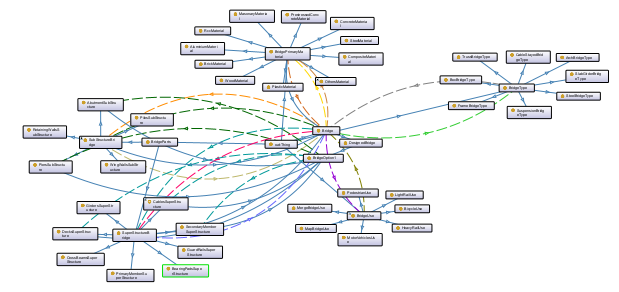Bridge
- Ontology
Introduction
Ontology is basically the study of different things and how those things relate to each other. It’s like a map that involves different concepts, their roles, and relationships to understand how everything links to each other. In ontology there are many steps, like first of all we have to define the purpose of the ontology and determine the specific application it will serve.
Purpose of this Ontology
The title of this ontology is bridge. The bridge has different purposes, such as being used for pedestrians, transportation, or mixed use. Bridges have many structural parameters and different loading conditions, like dead load, live or wind load, etc. So on the basis of the requirements we designed any bridge, like for heavy traffic loads we have to consider a lot of parameters, while just for pedestrians our bridge parameters are few to consider.
Scope of this Ontology
The scope of this ontology includes the physical components and the materials used for the construction, including the main material and secondary material, along with different types of bridges. It also describes the relationship between these components and how these components influence each other.
Intended users of this Ontology
Intended end users of this ontology include structural engineers, data engineers, architects, civil and design engineers, researchers, and urban planners who will utilize it to collect data, design, construct, and maintain bridges effectively. Additionally, different authorities can use this ontology to get an idea about the bridge design and can rely on compliance with safety standards and bridge operation efficiently.
Intended use of this Ontology
The intended use of this ontology is to provide a structured framework for modeling and managing various aspects of bridge design, construction, and operation. This includes the physical components of the bridge, their materials, bridge type, their use, and load-bearing capacity, along with the interrelationship among these elements. This includes the bridge’s physical components, materials, load-bearing capacity, structural types, and functional uses, as well as the interrelationships among these elements.
Domain of Ontology
The domain of this ontology is focused on bridges, encompassing various aspects of bridge design, construction, and use. The ontology aims to provide a structured representation of these elements and their relationships to facilitate better understanding, analysis, and decision-making in bridge engineering.
Onto Graf of Ontology
Engineering Examples of Ontology:
Bridge Structural Health Monitoring Ontology: This ontology integrates information about structural parameters to create a comprehensive view of a bridge’s health. It is used in SHM systems that automate the monitoring and reporting of structural health. Engineers can identify the risks by looking into the ontology and can take preventive measures before failure of the bridge elements.
Bridge Inspection Ontology: Ontology includes different classifications, like a specific class for materials used for bridge construction; it helps in creating the reports for the bridge inspection. The aim of ontology is to standardize the way through which incident data is recorded and analyzed. So for bridge inspectors and civil engineers, this ontology can be very helpful.
Bridge Design and Maintenance Ontology (BDMO): Ontology provides a clear framework for materials and design standards, which can be helpful for engineers, designers, and maintenance teams to take decisions in bridge management and maintenance and to take further steps for the improvement of the structure.
Conclusion
The bridge design ontology provides a structured way to organize and classify information related to bridge design. By dividing bridges into specific categories, identifying key components, and defining their purposes, this ontology offers a clear and systematic approach to both designing and analyzing bridges. The use of logical rules ensures that the information within the ontology remains accurate and consistent. Additionally, tools like Onto Graf help visualize the relationships and hierarchies, making it easier to understand the connections within the model. If standardized rules are applied, ontology created by different users and designers can be combined into a larger, unified system. This comprehensive ontology could then describe all types of bridge systems and the connections between their components.
References
- Adams, C., & Smith, D. (2017). “An Ontology for Bridge Inspection Data.” Proceedings of the 2017 International Conference on Engineering Design.
- Detail about bridge components (Site URL)
- Fazio, A., Montuori, L., & Ursini, T. (2013). “A Bridge Design and Maintenance Ontology for the Management of Knowledge in Bridge Engineering.” International Journal of Computer Applications in Technology, 48(4), 285-296.
- Brief Concept about Ontology (Site URL)
- Zhao, S., & Li, M. (2018). “Development of a Bridge Structural Health Monitoring Ontology.” Proceedings of the 2018 International Conference on Intelligent Transportation Engineering.
- Detail about bridges (https://testbook.com/civil-engineering/parts-of-a-bridge)
- Krötzsch, M., Vrandecic, D., & Völkel, M. (2006). Semantic MediaWiki. Proceedings of the 5th International Semantic Web Conference (ISWC). Springer, pp. 935-942. DOI: 10.1007/11926078_68.
